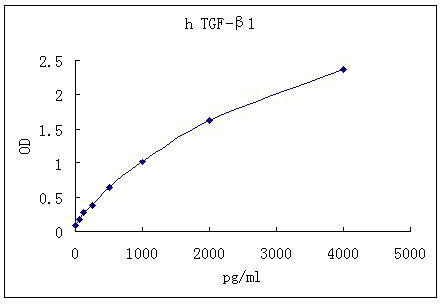Human TGF-beta1 ELISA Kit (96-well)
CNY 3,940.00
Specifications
| Product Data | |
| Description | Human TGF-beta1 ELISA Kit (96-well) |
| Size | 1 x 96 wells |
| Format | 96-well strip plate |
| Assay Type | Solid Phase Sandwich ELISA |
| Assay Length | 3 hours |
| Signal | Colorimetric |
| Curve Range | 62.5-4000pg/ml |
| Sample Type | Cell culture supernatant, serum, plasma (EDTA, citrate, heparin) |
| Sample Volume | 20 uL |
| Specificity | Natural and recombinant Human TGF-β1 Ligand |
| Sensitivity | 15pg/mL |
| Reactivity | Human |
| Interference | No significant interference observed with available related molecules. |
| Components |
|
| Background | Transforming growth factor (TGF), a Â?factorÂ? that promoted the transformation of cultured fibroblasts into a tumor-like phenotype, was subsequently found to be more of a tumor suppressor than tumor promoter and to be a mixture of two proteins, TGF-. and TGF-.. These molecules are members of a superfamily that includes TGF-.1 through 5, bone morphogenic proteins, activins and inhibins. It plays a critical role in cellular growth, development, differentiation, proliferation, extracellular matrix (ECM) synthesis and degradation, control of mesenchymal-epithelial interactions during embryogenesis, immune modulation, apoptosis, cell cycle progression, angiogenesis, adhesion and migration and leukocyte chemotaxis. Originally, TGF-.1 was separated from platelets and later found that TGF-.1 can be expressed in many organizations. Human TGF-.1 is a 25kDa, disulfide-linked, non-glycosylated homodimer. Biological activity of TGF-.1 is regulated by a number of receptors, including receptor I (53-65KD), receptor II (83-110KD), receptor III (250-310KD), receptor-IV (60KD) and receptor V (400KD). TGF-.1 is the key mediator in the pathophysiology of tissue repair and human fibrogenesis: balance between production and degradation of type I collagen, and fibrosis and scarring in organ and tissue. TGF-.1 exhibits important immunoregulatory features of partially adverse character: TGF-.1 inhibits B and T cell proliferation, differentiation and antibody production as well as maturation and activation of macrophages. TGF-.1 is synthesized, with only a few exceptions, by virtually all cells, and TGF receptors are expressed by all cells. TGF-. affects nearly every physiological process in some way; its systemic and cell-specific activities are too complicated to review here. There are, however, three fundamental activities: TGF-.1 modulates cell proliferation, generally as a suppressor; TGF-.1 enhances the deposition of extracellular matrix through promotion of synthesis and inhibition of degradation; TGF-.1 is immunosuppressive through a variety of mechanisms. The specific action of TGF-. on a particular cell depends on the exact circumstances of that cellÂ?s environment. |
| Gene Symbol | TGFB1 |
| Standard Curve |

Representative standard curve for TGF-?1 ELISA. TGF-?1 was diluted in serial two-fold steps in Sample Diluent.
|
Documents
| Product Manuals |


 United States
United States
 Germany
Germany
 Japan
Japan
 United Kingdom
United Kingdom
 China
China

